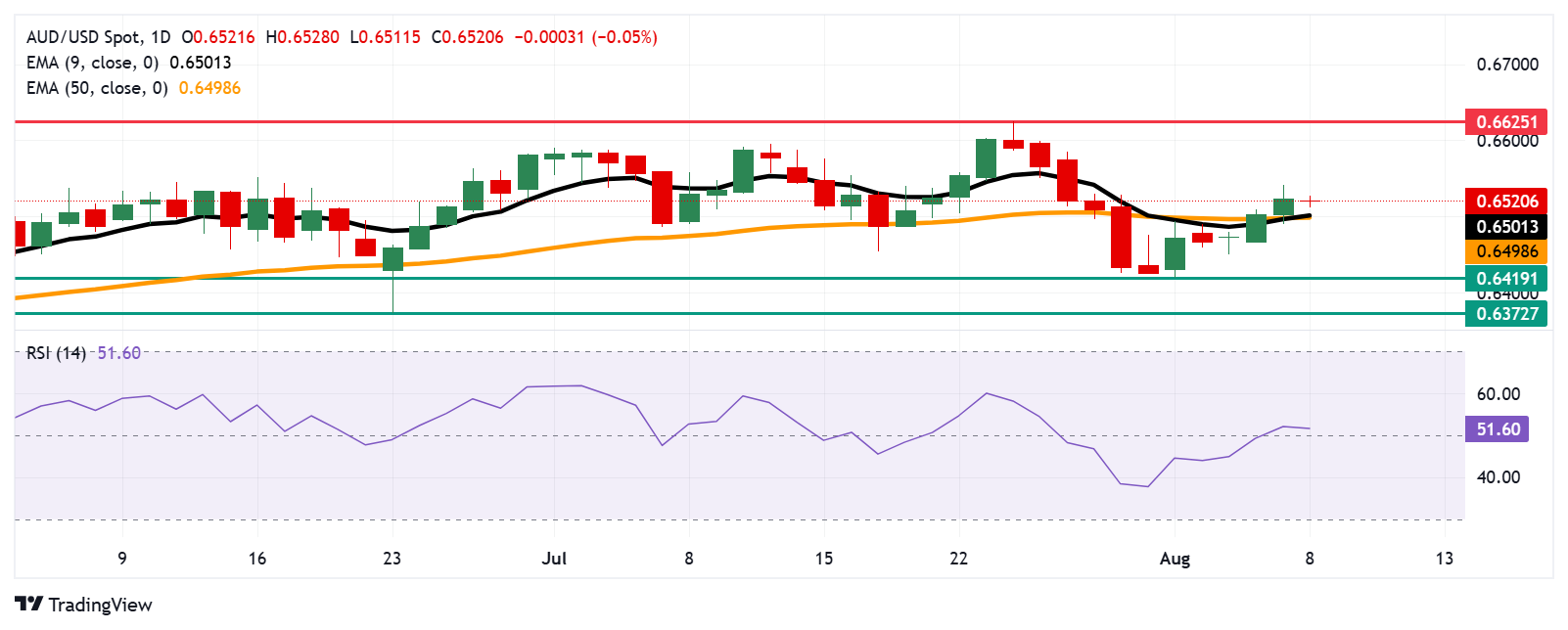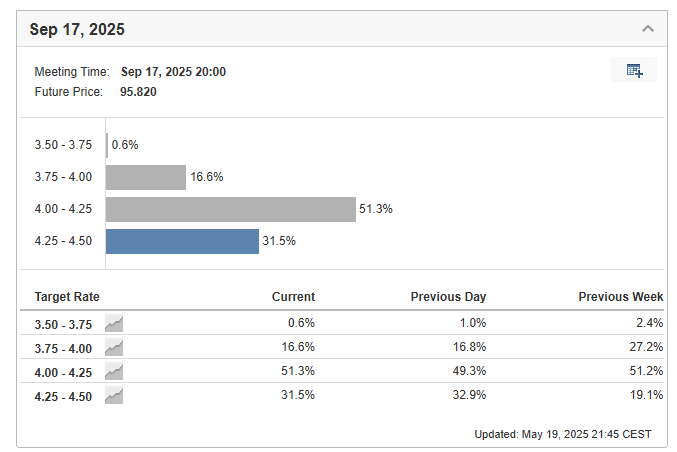- The Australian Dollar declines as RBA is widely expected to deliver a 25 basis point rate cut next week.
- The prospects for an RBA rate cut have strengthened as core inflation eased, with continued economic momentum in June.
- Trump has nominated Stephen Miran to replace Adriana Kugler on the Federal Reserve Board of Governors.
The Australian Dollar (AUD) depreciates against the US Dollar (USD) on Friday, after three days of gains. The AUD/USD pair loses ground as traders are pricing in over 92% odds of a 25 basis point rate cut by the Reserve Bank of Australia (RBA) next week, which would bring the cash rate down to 3.60%.
The likelihood of an RBA rate cut has increased as core inflation eased to 2.7% in June, well within the RBA’s 2–3% target, along with rising unemployment and slowing wage growth. Supporting this outlook, Australia’s Trade Surplus increased to 5,365 million month-over-month in June, surpassing the expected 3,250 million, while exports grew by 6.0% month-over-month, signaling continued economic momentum.
According to Reuters, US President Donald Trump warned China, Australia’s close trading partner, that he could impose further tariffs similar to the 25% levies announced earlier on India over its Russian Oil purchases, depending on future developments.
Australian Dollar faces challenges as US Dollar recovers recent losses
- The US Dollar Index (DXY), which measures the value of the US Dollar against six major currencies, is gaining ground and trading around 98.10 at the time of writing.
- US President Donald Trump has nominated Stephen Miran, chair of the Council of Economic Advisors, to succeed Adriana Kugler on the Federal Reserve Board of Governors. Traders will also keep their eyes on Trump’s plans to replace Fed Chair Powell. Fed Governor Christopher Waller is emerging as a top candidate to serve as the central bank’s chair among Trump’s advisers, per Bloomberg.
- Traders are pricing in nearly a 93% possibility of a 25 basis point (bps) cut in September, up from 48% a week ago, according to the CME FedWatch tool. The expectations for Fed rate cut next month, with another possible move in December, are boosted as new applications for unemployment insurance in the United States (US) increased, following the July US Nonfarm Payrolls (NFP) report pointed to a cooling labor market.
- US Initial Jobless Claims showed that the number of US citizens submitting new applications for unemployment insurance increased to 226K for the week ending August 2. This figure came in above the market consensus of 221K and was higher than the previous week’s 218K.
- President Trump announced plans to raise tariffs on pharmaceuticals to as much as 250% and, in the latest move, impose a 100% levy on semiconductor imports. Trump’s sweeping retaliatory tariffs took effect on Thursday, with rates ranging from 10% to 41%, fueling concerns about their potential impact on the US economy.
- Federal Reserve Bank of San Francisco President Mary Daly said on Wednesday that the Fed still has some ground to cover on its fight with inflation pressures despite overall progress. Daly highlighted that the Fed may be forced to act soon without having the full picture.
- Boston Fed President Susan Collins and Fed Board of Governors member Lisa Cook cautioned that persistent uncertainty remains a major obstacle to effective policy transmission and challenges the central bank’s ability to manage interest rates efficiently.
- The US and China were unable to reach an agreement on extending the 90-day tariff pause during their latest round of talks in Stockholm, Sweden. The current pause is set to expire on August 12, with the final decision resting in the hands of US President Donald Trump. In the meantime, US tariffs have been lowered from 145% to 30%, while Chinese tariffs have been reduced from 125% to 10%.
- China’s Trade Balance arrived at CNY705.10 billion in July, expanding from the previous figure of CNY585.96 billion. Exports rose 8.0% YoY in July following 7.2% in June, while imports increased 4.8% YoY against 2.3% recorded previously. In US Dollar (USD) terms, China’s Trade Balance arrived at +98.24 billion versus +105 billion expected and +114.77 billion priors.
- Australia was spared from the latest United States (US) tariff hikes, indicating that President Donald Trump had left the 10% baseline tariffs on Australian goods unchanged.
Australian Dollar remains above 0.6500, near nine-day EMA
The AUD/USD pair is trading around 0.6510 on Friday. Technical analysis on the daily chart suggests a bullish market sentiment, with the 14-day Relative Strength Index (RSI) positioning above the 50 level. Additionally, the pair remains above the nine-day Exponential Moving Average (EMA), signaling that short-term momentum is strengthening.
On the upside, the AUD/USD pair could explore the area around the psychological level of 0.6600, followed by the nine-month high at 0.6625, which was recorded on July 24.
The AUD/USD pair may test the nine-day EMA at 0.6501, aligned with the 50-day EMA at 0.6498. Further declines below could weaken the short- and medium-term price momentum and prompt the pair to test the two-month low of 0.6419, which was recorded on August 1, followed by a three-month low at 0.6372, recorded on June 23.
AUD/USD: Daily Chart

Australian Dollar PRICE Today
The table below shows the percentage change of Australian Dollar (AUD) against listed major currencies today. Australian Dollar was the weakest against the Canadian Dollar.
| USD | EUR | GBP | JPY | CAD | AUD | NZD | CHF | |
|---|---|---|---|---|---|---|---|---|
| USD | 0.21% | 0.14% | 0.19% | -0.01% | 0.03% | -0.13% | 0.15% | |
| EUR | -0.21% | -0.05% | 0.00% | -0.19% | -0.14% | -0.23% | -0.05% | |
| GBP | -0.14% | 0.05% | 0.06% | -0.14% | -0.19% | -0.06% | -0.07% | |
| JPY | -0.19% | 0.00% | -0.06% | -0.19% | -0.21% | -0.28% | -0.01% | |
| CAD | 0.00% | 0.19% | 0.14% | 0.19% | 0.06% | 0.06% | 0.12% | |
| AUD | -0.03% | 0.14% | 0.19% | 0.21% | -0.06% | 0.00% | 0.04% | |
| NZD | 0.13% | 0.23% | 0.06% | 0.28% | -0.06% | 0.00% | 0.12% | |
| CHF | -0.15% | 0.05% | 0.07% | 0.00% | -0.12% | -0.04% | -0.12% |
The heat map shows percentage changes of major currencies against each other. The base currency is picked from the left column, while the quote currency is picked from the top row. For example, if you pick the Australian Dollar from the left column and move along the horizontal line to the US Dollar, the percentage change displayed in the box will represent AUD (base)/USD (quote).
Australian Dollar FAQs
One of the most significant factors for the Australian Dollar (AUD) is the level of interest rates set by the Reserve Bank of Australia (RBA). Because Australia is a resource-rich country another key driver is the price of its biggest export, Iron Ore. The health of the Chinese economy, its largest trading partner, is a factor, as well as inflation in Australia, its growth rate and Trade Balance. Market sentiment – whether investors are taking on more risky assets (risk-on) or seeking safe-havens (risk-off) – is also a factor, with risk-on positive for AUD.
The Reserve Bank of Australia (RBA) influences the Australian Dollar (AUD) by setting the level of interest rates that Australian banks can lend to each other. This influences the level of interest rates in the economy as a whole. The main goal of the RBA is to maintain a stable inflation rate of 2-3% by adjusting interest rates up or down. Relatively high interest rates compared to other major central banks support the AUD, and the opposite for relatively low. The RBA can also use quantitative easing and tightening to influence credit conditions, with the former AUD-negative and the latter AUD-positive.
China is Australia’s largest trading partner so the health of the Chinese economy is a major influence on the value of the Australian Dollar (AUD). When the Chinese economy is doing well it purchases more raw materials, goods and services from Australia, lifting demand for the AUD, and pushing up its value. The opposite is the case when the Chinese economy is not growing as fast as expected. Positive or negative surprises in Chinese growth data, therefore, often have a direct impact on the Australian Dollar and its pairs.
Iron Ore is Australia’s largest export, accounting for $118 billion a year according to data from 2021, with China as its primary destination. The price of Iron Ore, therefore, can be a driver of the Australian Dollar. Generally, if the price of Iron Ore rises, AUD also goes up, as aggregate demand for the currency increases. The opposite is the case if the price of Iron Ore falls. Higher Iron Ore prices also tend to result in a greater likelihood of a positive Trade Balance for Australia, which is also positive of the AUD.
The Trade Balance, which is the difference between what a country earns from its exports versus what it pays for its imports, is another factor that can influence the value of the Australian Dollar. If Australia produces highly sought after exports, then its currency will gain in value purely from the surplus demand created from foreign buyers seeking to purchase its exports versus what it spends to purchase imports. Therefore, a positive net Trade Balance strengthens the AUD, with the opposite effect if the Trade Balance is negative.







